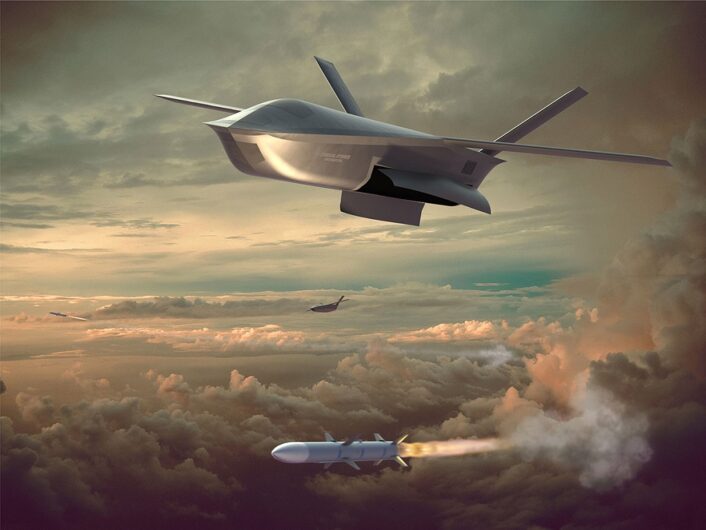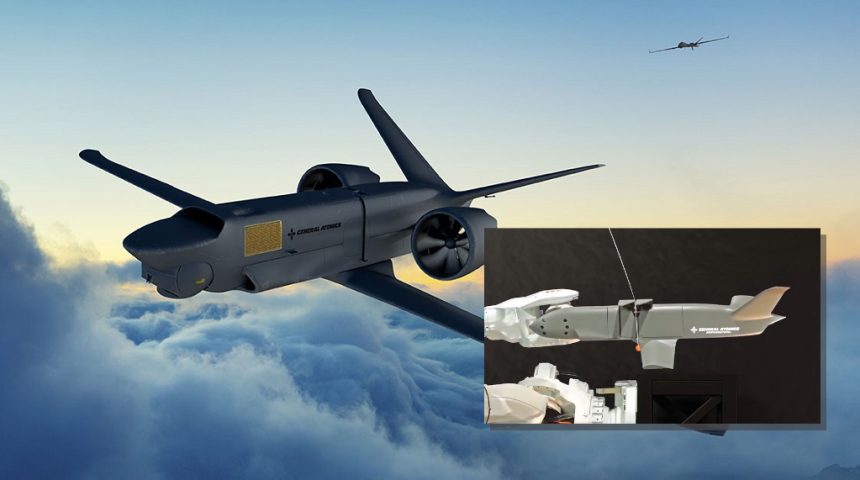The company showcased the technology that will allow the in-flight recovery of the Sparrowhawk SUAS, as well as a first look at the new Longshot drone being developed for DARPA.
Last year, General Atomics (GA-ASI) unveiled its Sparrowhawk air-launched and air-retrievable Small Unmanned Aircraft System (SUAS). Recently, the company released more details about the system, including the mechanism that will allow the inflight recovery by its “mothership”. The occasion was provided by the publication of an overview of the advent of SUAS and their evolution, as envisioned by GA-ASI.
Sparrowhawk is described by GA-ASI as a game-changing SUAS which an aircraft such as the MQ-9 Reaper can carry under its wings, as it might a traditional payload like a sensor pod or a fuel tank (it weighs just 500 lb), and which can be launched and then recovered in mid-flight when the “mothership” reaches an area of interest on a mission, something that few remotely operated aircraft have ever done until now.
Meet our smaller additions to the #UASFamily! These #SUAS products are game changers – smaller, swifter, and problematic for an adversary to spot. Stay tuned to learn more about each remarkable addition to our product line!https://t.co/kV1SG54Ura#Sparrowhawk pic.twitter.com/htOYpASykm
— GA-ASI (@GenAtomics_ASI) August 3, 2021
Sparrowhawk is considered difficult to spot by adversaries as it is programmed to fly low and relatively fast, being able to fly between 80 to 150 KIAS at altitudes up to 25,000 ft. This way the small drone can provide distributed and disaggregated sensors across the battle space, below the weather sensor coverage, attritable sensor capability in highly contested environments and collaborative autonomy for kill chain closure, capabilities that are possible thanks to Sparrowhawk’s constant connection with the launching aircraft which is used to send back vital information for decision making.
The Sparrowhawk might surveil an area for hours and turn back to rendezvous with the mothership holding at a safe distance, thanks to its hybrid electric propulsion system that allows an endurance of more than ten hours and a range of 500 nautical miles. Once in the safe area, well away from hostile warplanes or anti-air systems, the larger UAS can snatch the Sparrowhawk out of the sky via the integrated in-flight recovery system and continue its mission.
The integrated in-flight recovery system is a very interesting piece of technology. The mothership, which in the GA-ASI video presentation is an MQ-9B SkyGuardian, deploys a towline from inside the pylon used by Sparrowhawk, trailing a small orange spherical mass which serves the double purpose of stabilizing the towline and allowing the SUAS to grab the cable.
Once Sparrowhawk is in position near the towline, a small flap on the left side of its fuselage opens to help the cable get near the aircraft as it maneuvers. Then, a second flap opens in front of the first one, blocking the towline in position as the orange mass is caught between the two flaps before both flaps close securing the line. The SUAS wings then return to their stowed position by rotating 90 degrees and the mothership starts retracting the towline to secure Sparrowhawk under the pylon.
The company had already anticipated last year that the expendable sUAS will enable EW/SIGINT (Electronic warfare/SIGnals INTelligence) and ISR (Intelligence, Surveillance, Reconnaissance) missions in a contested environment, thanks to its swappable 60-lb payload in the nose. Among the payload options the company mentioned imaging radar, SIGINT/ELINT, jamming and day/night imaging sensor packages.
A further example was provided with this year’s overview, stating that a SkyGuardian could release a Sparrowhawk to search for hostile anti-air systems, probing a denied environment so that it could report back about the radar or other systems that powered on or detected it. Sparrowhawk could then respond with an electronic attack of its own to clear the way for other aircraft coming in behind it, jamming an enemy radar to deny its ability to sense a strike package passing through the area, or supporting Suppression of Enemy Air Defenses (SEAD) missions.
Another SUAS was also featured in the overview provided by GA-ASI, called Longshot.
Developed under a contract for DARPA (Defense Advanced Research Projects Agency), Longshot is designed to be launched from larger UAS or manned aircraft while in hostile airspace and defend the mothership from hostile aircraft by using its air-to-air missiles, either by sweeping the route ahead of the manned aircraft or staying in formation in a close escort role.
An interesting example mentioned by GA-ASI is the employment of Longshot by bombers, giving them an “emergency” air-to-air capability: “Imagine if a friendly bomber was enroute during a combat mission and allied battle networks detected the approach of hostile fighters. LongShot would let the bomber crew go on offense against the threat without the need for its own escorts or the retasking of friendly fighters, preserving its ability to service its targets as planned.”

Longshot features a stealthy design with a V-tail, straight wings and internal weapons bays. No info were provided about the dimensions, however the drone is represented armed with AIM-120 AMRAAM medium-range radar guided missiles and the weapons bays where they are carried occupy about half the length of the drone, so the total length could be around 7 or 8 meters, as the AMRAAM is 3.7 meters long. Also, no info were provided about the engine, which is not visible in the image.
DARPA’s LongShot program was announced earlier this year and has awarded contracts to General Atomics, Lockheed Martin, and Northrop Grumman for preliminary Phase I design work. Northrop Grumman also unveiled a concept art of the design that will be submitted for the program, showing a jet-powered drone with V-tail and sweptback or delta wings. Contrary to GA-ASI proposal, this one seem to be centered around the external carriage of the air-to-air weapons, however some panels on the fuselage may suggest also the presence of additional weapons bays.









